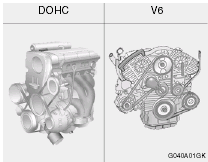Changing the oil and filter

The engine oil and filter should be changed at those intervals specified in the maintenance schedule in Section 5. If the car is being driven in severe conditions, more frequent oil and filter changes are required.
The procedure for changing the oil and filter is
as follows:
1. Park the car on level ground and set the
parking brake. Start the engine and let it
warm up until the needle on the coolant
temperature gauge moves above the lowest
mark. Turn the engine off and place the gear
selector lever in "P" (automatic) or reverse
gear (manual transaxle).
2. Open the hood and remove the engine oil filler cap.
3. Slide underneath the car and loosen the drain plug by turning it counterclockwise with a wrench of the proper size. Be sure that a drain pan is in position to catch the oil as it drains out, then remove the drain plug.
WARNING:
Be very careful when draining the engine oil
as it may be hot enough to burn you!
4. When the oil has stopped draining, replace the drain plug using a new washer and retighten by turning it clockwise.
Oil pan drain plug tightening torque: 3.5 ~ 4.5 kgf.m (2.7L).
4.0 ~ 4.5 kgf.m (2.0L).
5. Remove the oil filter by turning it counterclockwise with a oil filter wrench of the proper size. A certain amount of oil will come out when you remove the filter. So be sure to have your drain pan in place underneath it.
6. Install a new oil filter in accordance with the instructions on the carton or on the filter itself.
Do not over-tighten. (Tightening torque : 1.2 ~ 1.6 kgf.m) Be sure that the mounting surface on the engine is clean and that the old gasket is removed completely. Lubricate the new gasket on the filter with clean engine oil before installation.
7. Remove the engine oil level dipstick.
8. Refill the crankcase with the recommended engine oil. Refer to the specification in chapter 9 for engine oil capacity.
CAUTION:
Slowly pour the recommended oil using by
a funnel. Do not overfill! Engine damage
may occur if overfilled.
9. Start the engine and check to be sure no oil is leaking from the drain plug or oil filter.
10.Shut off the engine and recheck the oil level.
NOTE:
Always dispose of used engine oil in an
environmentally acceptable manner. It is
suggested that it be placed in a sealed
container and taken to a service station for
reclamation. Do not pour the oil on the
ground or put it in with the household
trash.
PROPOSITION 65 WARNING: This product contains a chemical known to the State of California to cause cancer.
Used engine oil may cause irritation or cancer of the skin if left in contact with the skin for prolonged periods of time. Used engine oil contains chemicals that have caused cancer in laboratory animals. Always protect your skin by washing your hands thoroughly with soap and warm water as soon as possible after handling used oil.
See also:
Air bag warning label (if equipped)
Air bag warning labels, some required by the U.S. National Highway Traffic Safety
Administration (NHTSA), are attached to alert the driver and passengers of potential
risks of the air bag syst ...
Windshield wiper blades
The wiper blades should be carefully inspected
from time to time and cleaned to remove accumulations
of road film or other debris. To clean
the wiper blades and arms, use a clean sponge
or cloth ...
Sunshade
The sunshade will be opened with the glass panel automatically when the glass
panel is slid.You will have to close it manually if you want it closed.
CAUTION
The sunroof is made to slide togethe ...


